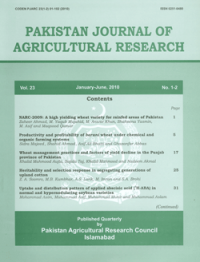COMBINING ABILITY ANALYSIS IN VARIOUS INBRED LINES OF MAIZE (ZEA MAYS L.)
Syed Asif Imran Shah*, Shah Jehan Khan**, Abdul Aziz Baloch*** ,
Obaid Ullah Sayal**, Kalim Ullah* andShujaat Ali**
ABSTRACT
An experiment to study combining ability effects through 6 × 6 diallel model in maize inbred lines, was laid out in randomized complete block design with three replications at Agricultural Research Institute, Dera Ismail Khan, Pakistan, during 2012. Variance analysis exhibited highly significant (P≤0.01) variation among genotypes for days -1 -1 -1 to 50% silking, ear length, kernel rows ear , kernels row , kernels ear and grain yield. Mean square values due to general combining ability were -1 highly significant (P≤0.01) for all studied attributes except kernels ear and grain yield. Highly significant variations for specific combining ability of direct and reciprocal effects were observed for all attributes. Azam -1 proved good combiner for days to 50% silking and kernel rows ear while -1 Islamabad Gold for kernels ear and grain yield. Islamabad White × Sadaf was the best combiner for grain yield. For reciprocal effects, BS-I × Sahiwal -1 -1 2002 proved good combiner for kernels row and kernels ear while BS-I × Islamabad White for grain yield. Selection in early generation will be more effective in Islamabad White whereas Islamabad Gold in later generation due to dominant and additive genetic background, respectively.
To share on other social networks, click on any share button. What are these?






